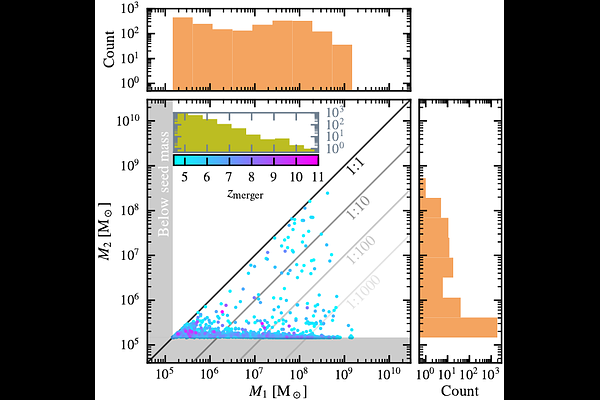First Light And Reionization Epoch Simulations (FLARES) -- XIX: Supermassive black hole mergers in the early Universe and their environmental dependence

First Light And Reionization Epoch Simulations (FLARES) -- XIX: Supermassive black hole mergers in the early Universe and their environmental dependence
Shihong Liao, Dimitrios Irodotou, Maxwell G. A. Maltz, Christopher C. Lovell, Zhen Jiang, Sophie L. Newman, Aswin P. Vijayan, Paurush Punyasheel, William J. Roper, Louise T. C. Seeyave, Sonja Soininen, Peter A. Thomas, Stephen M. Wilkins
AbstractThe upcoming space-based gravitational wave (GW) observatory, LISA, is expected to detect GW signals from supermassive black hole (SMBH) mergers occurring at high redshifts. However, understanding the origin and growth of SMBHs in the early Universe remains an open problem in astrophysics. In this work, we utilize the First Light And Reionization Epoch Simulations (FLARES), a suite of cosmological hydrodynamical zoom-in simulations, to study SMBH mergers at $5 \lesssim z \lesssim 10$ across a wide range of environments. Most mergers in FLARES involve secondary SMBHs near the seed mass ($m_{seed} \approx 1.5 \times 10^{5} M_{\odot}$) while primary SMBHs span up to $10^{9} M_{\odot}$, resulting in mass ratios from $q \sim 10^{-4}$ to $1$, with a peak at $q \sim 1$. The number of mergers increases rapidly towards lower redshifts, and the comoving total number density scales with overdensity as $n_{merger} = 10^{-3.80} (1 + \delta)^{4.56}$. Denser regions host more massive mergers, with higher merger redshifts and lower mass ratios. Within the FLARES redshift range, LISA is expected to detect mergers with $10^{5} \lesssim M_{tot} / M_{\odot} \lesssim 10^{8}$ and $q \gtrsim 10^{-2}$, corresponding to a detection rate of 0.030 $yr^{-1}$ for events with signal-to-noise ratio $SNR \geq 10$. Our study demonstrates the sensitivity of GW predictions at high redshifts to SMBH seed models and merger time delays, highlighting the need for improved modeling in future cosmological simulations to maximize LISA's scientific return.